Terebess
fűszerkalauz
«
vissza a Terebess Online nyitólapjára
«
vissza a Kertek
és konyhák indexlapra
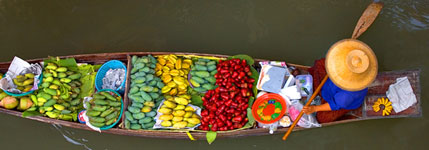
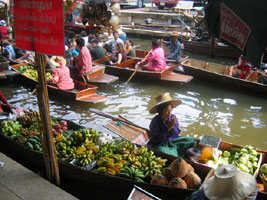
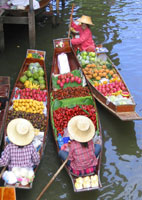

Thai ízek
Zöldfűszerek
Fűszerek
Gyümölcsök
Zöldségek
Teák
Receptek
Főző
és evőeszközök
•
Thai
bazsalikomfajták
- Ocimum spp.
Basils
Thaiföldön háromféle bazsalikomot használnak:
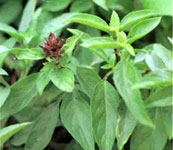
Édes bazsalikom - Ocimum basilicum L.
Bai-Hora-Pah, bai horapa, báy horopá, bai horah ba, bai horapa, ho lap har, hora pa, horapha
tarp hao (világoszöld), ho lap har (zöld)
Thai basil, sweet basil
‘Sweet Basil’ which is mild in flavour. Fresh young shoots are served with fried roll-noodles, or as a typical hot and sour chopped meat salad called “larp”. It is also an ingredient of green curry soup.
Eredet: India és a távol-keleti térség
Leírása: Bazsalikomokhoz teljesen hasonló azonban levelei kisebbek, haragoszöldek, kissé fogazottak és az egész növény ánizsillatot áraszt magából.
Felhasználása: Főként a piros és zöld curry-pasztában, a klasszikusnak mondható édes-savanyú mártásban, de egyéb távol-keleti ételekben is, salátákban, szószokban és tésztaételekben használják.
http://www.kitazawaseed.com/seeds_thai_sweet_basil.html
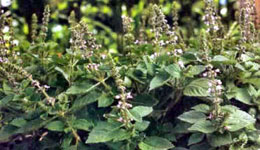
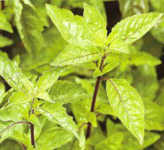
Szent bazsalikom - Ocimum sanctum
Bai Gra-pao, Bai Grapow, báy kápró, bai gaprow, bai ka phrao, gra pow, krapao
Thai Holy Basil, hot basil
There are two types: a pale green or white type, and a red type, with purple reddish tinged leaves. Holy basil has a clove-like taste. Store wrapped in newspaper in the refrigerator. Use it soon after buying. Available more readily in summer months.
This variety tastes rather like cloves, and is just as pungent, which explains its alternative name; hot basil. The leaves release their full flavour only when cooked. Use holy basil as fresh as possible In Thailand it is also sometimes sautéed with frogs' legs. Hindus believe that basil is sacred and they like to plant it in religious sanctuaries. With a slightly hot flavour, though not so hot as pepper, holy basil leaves are used in many Thai dishes, including stir-fried meat dishes and curries. Basil is also used for medical purposes, to treat indigestion and to stimulate the appetite.
http://www.kitazawaseed.com/seeds_holy_basil.html
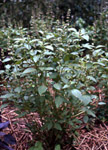
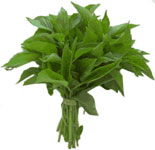
Pihés bazsalikom, citrombazsalikom - Ocimum carnus (Ocimum citriodorum) - Ocimum americanum L.
Bai Mang Luk, bai maeng Luck, Maeng-luck, báy mánglák, manglak
lemon basil
‘Hoary (white) Basil’ is also mild in flavour with a particular fragrance. Young leaves are served as a fresh vegetable in vermicelli known as ‘khanom cheen’. It is also used in Thai mixed vegetable soups called ‘kaeng liang’. The seeds are used in desserts and are included in slimming diets because the leaves swell when placed in liquid.
Hoary Basil sometimes called e-too is an annual herbaceous plant with slightly hairy and pale green leaves. It can be eaten either raw or cooked, and used as a flavouring. It is sometimes called lemon-scented basil but definitely has a peppery taste when chewed. Maeng-lak contains approximately 0.7% volatile oil. Therapeutic benefits include the alleviation of cough symptoms, and as diaphoretic and carminative agents. It's used in soups and to flavour steamed fish and vegetables. It has a real citrus-like aroma and flavour.
Lemon basil has a lemony flavour with tiny leaves and is usually sprinkled over salads or used in soups. Used much less frequently than sweet basil in Thai cooking.
http://www.herbsociety.org/basil/ocitriodorum.php

• Phak
cheethai - Coriandrum
sativum
Pak Chee Thai, korianderzöld
Cilantro (Pak Chee) is the leaf of the young coriander
plant, Coriandrum sativus, This member of the carrot
family similar to anise and has delicate leaves and
deep roots. When the plants reach maturity, they produce
abundant white flowers.. Coriander is the most common
herb used in Thai cooking. The whole plant is used--the
root, stem and leaves. The leaves are often chosen for
decoration. The seeds are roasted and then ground in
a spice mill and used in curry pastes. The leaves are
used for their fresh, peppery flavour, and as a garnish.
For storage, wash and dry the fresh herbs before placing
them in plastic bags in the refrigerator-they will keep
for 5-6 days. Dried coriander is not a suitable substitute.
Met Pak Chee, koriandermag
Coriander is the seed of Coriandrum sativum, a plant in the parsley family. The seed is globular and almost round, brown to yellow red, and 1/5 inch in diameter with alternating straight and wavy ridges. Coriander seed, with its clean, lemony flavour, is the major component of almost every 'curry powder' or spice mixture used in Thailand, as well as other curries. The flavour of freshly ground coriander is a world apart from that of ground coriander which has lost its fragrance.
koriandergyökér
•
Pak Chee Lao, kapor
Phak cheelao, Laos
coriander, laoszi koriander
Dill (Pak Chee Lao in Thai) is eaten raw and used in
soups and Hor Mok Pla (Steamed Fish Curry).
•
Bai Yah Nang
Yanang leaf
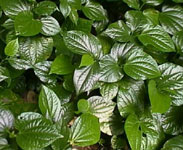
•
Cha
Plu - Piper
sarmentosum
Bai Cha-Ploo, Cha-Phlu
La Lot (Vietnam); Daun Kadok (Malaysia); Phak I Leut (Laos);
Betel Leaf, Wild Betel Leaf, Bitter
Leaf
Bitter Leaf (Chapoo in Thai and E-lert in Lao) is eaten
raw or used in soup or salads.The leaves used to make miang
kham, a delicious Thai recipe. The leaves are known in Thai
as bai cha-phloo. In some Asian supermarkets they may use
the Vietnamese spelling of "La Lop" leaves. In English they're
known as piper sarmentosum or "Betel" leaves. Somewhat bitter,
the taste is perfectly suited for miang kham. Or you can
wrap just about any Thai food in the leaves, such as fried
rice with a peanut or two, and pop them into your mouth.
The leaves are sold in bunches (see photo below). Leaves
are 3-4" wide. These leaves are commonly used in Thailand
as a stimulant, if mixed together with lime paste.
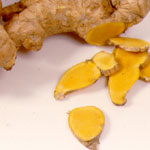
• Phlai - Zingiber
cassumunar Roxb.
gyógynövény
http://www.thaifloriade.thaigov.net/hort_cd/herb/html/08_Phlai.htm
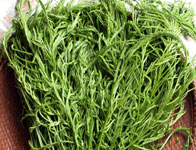
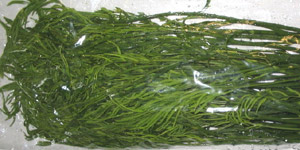
• Cha-Om
Acacia Cha-Om Leaf, akácia-levél
Cha-Om is a very unusual tasting (and smelling) vegetable
that is eaten raw or cooked with eggs.
A bitter green vegetable. Cha-om is used in omelette-style
dishes and in stir-fry cooking. Thai people eat with chili
dipping shrimp paste sauce (nam prik pla to).
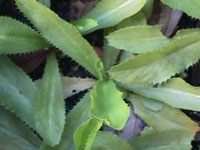
•
Pak
chee farang - Eryngium foetidum
Saw Leaf Herb, Thai Parsley, thai petrezselyem
Also known as the saw tooth herb, this takes its name from
the appearance of the leaves, which are long, slender and
serrated. The herb has a similar but rather more pungent
flavour than the coriander leaf. Saw leaf herb is used as
a flavouring for meat dishes.
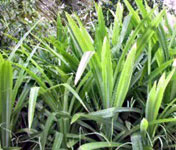
• Bai Toey Hom, padang
levél
Long narrow green leaves of a herbaceous plant used for
flavouring and colour. There is "no" substitute of the flavouring.
but green colouring may be used as a substitute for the
colour. Medicinal Uses: Maintains the heart and liver in
good condition, relieves fever and soothes sore throat.
http://www.simply-thai.com/Thai-Market_Thai_Herbs_and_Spices_Pandan_Leaf.htm
Bai Der-Y-Lek, Pandang leaf (small)
Bai Der-Y-Yai, Pandang leaf (big)
Bai Der-Y-Rok, Pandang with root
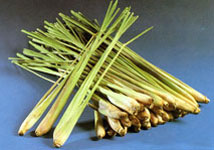
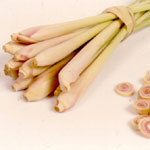
•
Ta-khrai
vagy
tak-rai - Cymbopogon
citratus [DC.]
Ta-Krai,
ázsiai citromfű, lemongrass
A növény szárát és leveleit használják. Üde
és citromos, leheletnyi rózsaillattal.
A nemzetséghez tartozó mintegy 55 faj túlnyomó részben Dél-Ázsiában,
Délkelet-Ázsiában és Ausztráliában honos. A kelet-indiai
citromfű (Cymbopogon flexuosus [Nees ex Steudel] J.F. Watson)
vadon nő Sri Lanka, India, Burma és Thaiföld területén,
a nyugat-indiai citromfű esetében azonban (C. citratus [DC]
Stapf) feltételezhető a betelepítés. Ebben az esetben nem
volna értelme a "keleti" és "nyugati"
megkülönböztetésnek. Mindkét fajtát nagy mennyiségben termesztik.
Az ételek finomítása szempontjából jelentősebb fajta a C.
citratus, a nyugat-indiai citromfű. Indiában illatszerek
készítéséhez és gyógynövényként termesztik, ezzel szemben
fűszernövényként nem. Konyhai felhasználása Sri Lankára
és Délkelet-Ázsiára korlátozódik.
A friss citromfű hasznosítása Délkelet-Ázsiára és Sri Lankára
jellemző, fűszerként Thaiföldön, Vietnamban, Kambodzsában
és Indonézia egyes részein kedvelt. Kiválóan illik szárnyasokhoz,
halakhoz és a tenger gyümölcseihez. Zsengébb része alkotója
a thaiföldi curry-pépnek. Levesbe az öregebb, fásabb részét
kissé megropogtatva egészben szokás belefőzni, majd kidobják.
A citromfű kellemes aromája az ízkompozíciókban soha nem
dominál. Szükség szerint a citromfű helyettesíthető citromillatú
mézfűvel (bár nem ugyanazt az aromát kapjuk; ugyanakkor
nem javasoljuk helyettesítését a sokkal intenzívebb aromájú
citromhéjjal).
A szárított citromfüvet felhasználása előtt rövid időre
vízbe kell áztatni ahhoz, hogy teljes aromájával örvendeztethessen
meg bennünket.
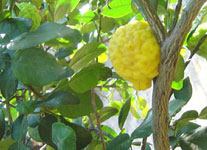
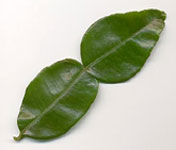
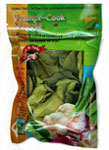
• Bai-makrut, kaffercitrom
levél - Citrus
hystrix DC.
kaffir
zöldcitrom (ma-krut) levele, green
kaffir lime leaves
A gyümölcs héját curry pasztába használják. A leveleknek
erős, különös aromája van, egészben vagy a vastag erekről
letépkedve a levéldarabjait tegyük az ételbe.
From the kaffir lime, In Thai called Bai Ma-Krut, which
has virtually no juice these fleshy green and glossy leaves
resemble a figure eight. Imparting a unique flavour, they
can be finely shredded and added to salads, or torn and
added to soups and curries. Can be substituted with other
lemon-flavoured herbs, but the best option is to freeze
the leaves when you can find them, as they retain all their
flavour and texture on thawing Kaffir lime leaves. . Use
them whole in soups such as Tom Yum, Tom Kha; and curries,
as an aromatic ingredient not meant to be eaten. Or slice
them into very fine, edible sliver. Either way, they add
a wonderful flower-like fragrance and taste.
Luuk-makrut, kaffir zöldcitrom, papeda, hosszútövisű narancs
The leaves, peel and juice of the Kaffir Lime are used as a flavouring in Thai cuisine. Imparting a unique flavour, they can be finely shredded and added to salads, or torn and added to soups and curries. Can be substituted with other lemon-flavoured herbs, but the best option is to freeze the leaves when you can find them, as they retain all their flavour and texture on thawing. The leaves and peel contain a volatile oil. The major therapeutic benefit of the juice is as an appetizer.
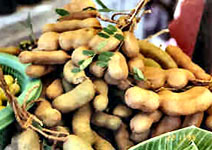
• Makam
sot
tamarind
fontos savanyító a thai konyhában
http://www.simply-thai.com/Thai-Market_Thai_Herbs_and_Spices_Sour_Tamarind.htm
makam piek, (ma kham piak) = tamarind-lé
tamarind water, soaked tamarind
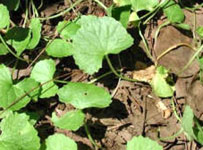
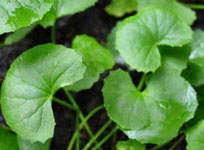
• Bai Bua Bok
Asiatic Pennywort
This is a small, annual, slender, creeping herb. It has
long-stalked, green reniform leaves with rounded apices
that have smooth texture with palmately netted veins. The
stems are creeping in nature, green to reddish green in
colour, interconnecting one plant to another. The flowers
are pinkish to red in colour, born in small, rounded bunches
near the surface of the soil. Each flower is partly enclosed
in 2 green bracts. The hermaphrodite flowers are minute
in size (less than 3 mm), with 5-6 corolla lobes per flower.
Each flower bears 5 stamens and 2 styles. Pennywort's rootstock
consists of rhizomes, growing vertically down. They are
creamish in colour and covered with root hairs. Fruits are
small and flattened.
Medicinal Uses : It has been used for wound healing, better
circulation, memory enhancement, cancer, vitality, general
tonic, respiratory ailments, detoxifying the body, treatment
of skin disorders (such as psoriasis and eczema), revitalizing
connective tissue, burns and scars treatment, clearing up
skin infections, slimming and edema, arthritis, rheumatism,
treatment of liver and kidneys, periodontal disease, strengthening
of veins (varicose veins), blood purifier, high blood pressure,
sedative, anti-stress, anti-anxiety, an aphrodisiac, immune
booster, anabolic and adaptogen etc.
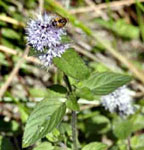
• Bai Sa-La-Nae
Sa-la-Nae, Marsh Mint
The fresh leaves of this herbaceous plant are used as a
flavouring and eaten raw in Thai cuisine. Volatile oil contents
give the plant several therapeutic uses, including carminative,
mild antiseptic, local anaesthetic, diaphoretic and digestant
properties. Mint (Sa-la-nae in Thai) is used in larb and
other salads and is served with noodle soup.
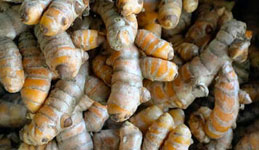
• Kha-Min, Kamin Khao
Turmeric roots, kurkumagyökér
A member of the ginger family, turmeric (Kamin) is an underground
stem or rhizome. It grows in clusters of small stubby fingers
with a dull, brown skin hiding its gorgeous fluorescent
orange meat. It has a faint, earthy taste, but colour is
the point here. Since colour is what matters in cooking
with this herb, ground dried turmeric works fine. Turmeric,
a relative of ginger, is used in many different dishes both
for it's yellow colour and flavour. It's available fresh,
frozen or powdered.
Kha-Min Pong
Turmeric powder, kurkumapor
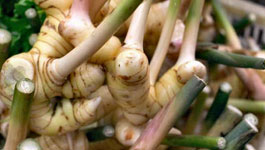
• Kha, hua kah
Galangal
Called galangal or 'Kha' in Thai. This is the type of ginger
Thai cook’s use most. The flavour is both more lemony and
more peppery than that of common ginger, and it has a richer
aroma. The skin is pale yellow, with pink-tinged knobs;
the interior is cream-colour. Kha is never eaten alone;
it is used as a flavouring component. We float large slices
into soups or chop and pound pieces into curry pastes. Medicinally,
galangal is classed as a digestive stimulant and "Thais
mix the grated root with limejuice" to treat stomach-ache.
Thais also believe that galangal can help respiratory ailments.
Galangal root ("hua kah"): This root is similar to ginger
root, but more delicate in flavour and texture. Preferably
fresh , but also available dried in slices or ground. The
most popular Thai dish using fresh galangal is "Tom Ka Gai",
chicken cooked in coconut milk. Dried pieces can be substituted.
Galangal is known as "laos" in Indonesia and "lengkaus"
in Malaysia.
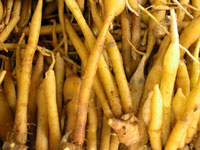
• Kra-chai
Tumicuni - Galingale
Kra-chai is a relative of the ginger root and milder in
flavour than ginger and galangal. The tubers are yellowish
with a brown skin and are shaped like finger hanging from
the main body. These tuber have a strong, distinctive aroma.
To prepare, scrape off the fine brown skin with a sharp
knife, then chop finely or slice lengthwise. Kra Chai is
one of main ingredients in Thai curry pastes, and the fresh
flesh is used sliced finely in fish curry dishes.
• Ka-aen, Wan-phraathit, Khingsai khingkaeng, Ka chai, Kra chai - Boesenbergia pandurata (Roxb.) Schltr.
fingerroot, kínai gyömbér
•
Khing
Gare, king
old ginger, közönséges gyömbér
The name Ginger comes from the Sanskrit word "sinabera"
meaning "shaped like a horn" because of its resemblance
to an antler. Ginger has over 400 members included in its
family. Ginger is an erect plant with thickened, fleshy
and aromatic rhizomes. Ginger is used in different forms
as a food, flavouring and spice. Ginger has a slightly biting
and hot note. Its aroma is rich, sweet, warm, and woody.
Always choose young fresh, firm, unwrinkled ginger rhizomes
and store them in a plastic bag so they don't dry out. It
is eaten raw or cooked and is used widely in many Asian
cuisines. Young ginger is good too as a marinated for chicken
or beef. Ginger's rhizomes contain a 1-2% volatile oil.
Ginger's therapeutic uses are as a carminative, antinauseant
and ant flatulence agent.

Khing On, king on
Young Ginger
Young Ginger (King On) is picked earlier than ginger and has a more subtle flavour
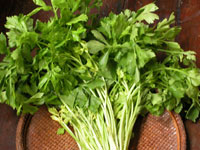
• Bai Khuen Chai
Thai zellerzöld
Thai celery is smaller, greener, thinner stemmed and with
more leaves than that found in Europe. It also has a much
stronger flavour and is used in Thai soups, sauces and salads.
Young celery leaves make an attractive garnish which enhances
the flavour of the food at the same time.
http://www.simply-thai.com/veg-images/thai-celery--bg.jpg
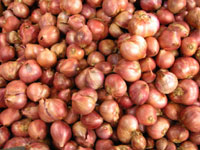
• Hom Daeng
thai mogyoróhagyma
Shallot or small red onions are annual herbaceous plants.
Underground bulbs comprise garlic-like cloves. These
small, zesty, Thai red onions are sweet and aromatic,
a very important ingredient in most Thai dishes. They
are used in curry paste, dips and salads. Red onion
is a good substitute for shallots and we recommend to
use only the first three layers of them. Medicinal properties:
Therapeutic uses included the alleviation of stomach
discomfort, and as antibelmintic, antidiarroheal, expectorant,
antitussive, diuretic and antiflu agents.
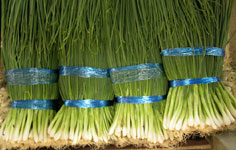
• Don-Hom
Spring Onions
Spring onions are a variety of onion harvested immature
before the bulb has formed. Both the green leaves and
white bulbs are used raw or cooked for their mild but
still pronounced onion flavour. Spring onions are also
known as scallions or spring onions. Spring onions are
used in Thai cooking for stir-fries and in soups. They
are also popular for garnishes, either sliced or cut
into tassels, then curled in iced water.
http://www.simply-thai.com/Thai-Market_Thai_Vegetables_Spring_Onions.htm
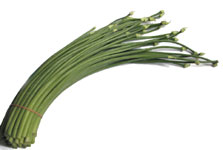
Dock Don Hom are the Stems and Flowering buds of Thai Spring Onions and are used raw or cooked for their mild but still pronounced onion flavour. Dock Don Hom are used in Thai cooking for stir-fries and in soups.
•
Kui
chai
Chinese Chives
These pungent herbs look more like long, flat spring
onions than their Western equivalent. The leaves are
peppery, crunchy and chewy. They are eaten raw and cooked
and are prized for both their texture and flavour. Spring
onions can be used as a substitute but they will not
have the distinctive garlic taste of Chinese chives.
Dok Kui Chai
Chive Flowers (Dok Gui Chai) are the flowering tips of chives and are used in stir-fries.
http://www.simply-thai.com/Thai-Market_Thai_Vegetables_Chinese_Chives.htm
•
Hom
Sot Keow
Green Onion
Green Onion (Hom Sot Keow) is used in many Thai salads
and dishes like Pad Thai.
http://www.simply-thai.com/Thai-Market_Thai_Vegetables_Green_Onion.htm
•
Hua
Hom
Vöröshagyma, onion
Onions are not as popular as shallots in Thai cooking
and those that are on sale tend to be fairly small.
Yellow in colour, they are quite pungent, with a sweet,
peppery flavour. Many Thai dishes are garnished with
crisp-fried onion flakes. You can buy these ready-fried
onions in tubs from Thai grocery stores.
•
Gratium,
krathiam, krátiám
fokhagyma
Garlic flavour is strongest when the cloves are squeezed
and their juice extracted, slightly less strong when
the cloves are grated or finely chopped, even less strong
when the clove are merely sliced, and mildest when whole
unbroken cloves are used. In addition, the longer garlic
is cooked, the milder it becomes. Garlic contains significant
amount of vitamin C, calcium and protein. It is also
rich in potassium, phosphorus, iron and zinc. Medicinally,
it is believed that garlic can reduce blood pressure
and cleanse the blood of excess glucose. It is also
said to alleviate flu, sore throats and bronchial congestion.
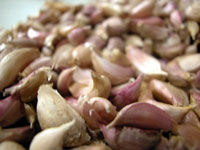
Garlic Bulb - Gratium Thon, Krathiam ton
krátiám dong = savanyított fokhagyma
This type of garlic is preferred for pickling with honey has bulbs with just one clove. These garlic rounds are not a separate variety of garlic but a natural phenomenon whereby a Garlic Bulb does not divide into many cloves. In the sorting of pickled garlic, 20 to 30 kilograms yields only 1 to 2 kilograms of garlic rounds, and therefore, they are expensive.
http://www.simply-thai.com/Thai-Market_Thai_Vegetables_Garlic.htm

Garlic Plant- Don Gratiem
It is young garlic plant which picked before the bulb has formed. The leaves are flat and folded lengthwise. They are stir-fired with seafood dishes.
http://www.simply-thai.com/Thai-Market_Thai_Vegetables_Ton_Gratiium.htm
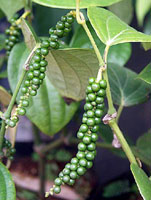
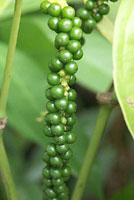
• Prik Thai, bors
Pepper is the dried berry of Piper nigrum. This vine which
can grow up to ten feet tall is indigenous to India and
Asia.The Pepper plant produces berries, they are dried and
ground with the skin on to give black pepper, or with the
skins off to give white pepper. White pepper is mainly used
in Thai cooking. Pepper is actually berries that are picked
about nine months after flowering. Black, white and green
peppercorn types. Black Pepper has a sharp, pungent aroma
and flavour. White Pepper is hotter, less subtle and mildly
fermented. Green Peppercorn is milder in flavour and has
a fresh taste. Green Peppercorns are available all year
round but are best towards the end of the rainy season.
Used as a spice and condiment, pepper contains a 2-4% volatile
oil. Therapeutic uses are as carminative, antipyretic, diaphoretic
and diuretic agents.
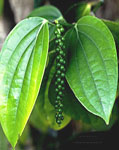
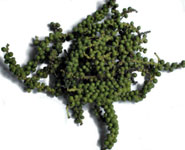
• Prig Thai On
Prik Thai On, fresh green peppercorns, friss (éretlen) fürtös zöldbors
Green Peppers are the almost mature pepper berries. They are used in curries made without coconut milk and in stir fried curries Medicinal properties: Pepper contains 2 to 4 % volatile oil. Therapeutic uses are as carminative, antipyretic, diaphoretic and diuretic agents.
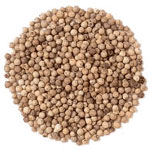
• Prig Thai Khow
white peppercorns, fehérbors
A teljesen megérett, sárgás-pirosas bogyókat 7-10 napra vízbe áztatják, megszabadítják a gyümölcshús vékony rétegétől, a héjtól, és a napon megszárítják. A visszamaradt szürke magocskákat többször megmossák, majd újból levegőn szárítják, amíg színük sárgás-fehéresre nem változik. A napon fehérített borsszem gömbölyű, 2-4 mm átmérőjű. A feketeborsból gépi hántolással is kinyerhető a fehér bors.
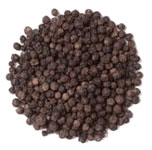
• Prig Thai Dum
Prik Thai (Dam-Khao), black peppercorns, feketebors
Amikor pirosodni kezdenek a buga legalsó termései, megkezdődik a szüret. Szárítás után lehúzzák a bugáról a még éretlen terméseket, és addig szárítják a levegőn, amíg azok ráncosak és barnás-feketék nem lesznek.
•
Nga, szezámmag - Sesamum indicum
Sesame
In Thai cooking, sesame seeds are used for oil and for flavouring.
These tiny seeds are rich in protein.
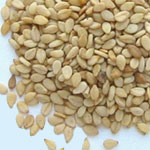
Nga Khow
fehér szezámmag, white sesame
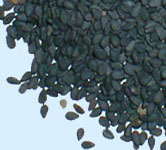
Nga Dum
fekete szezámmag, black sesame
•
Yi Ra
- Cuminum cyminum L.
cumin, rómaikömény
Cumin is the pale green seed of Cuminum cyminum, a small
herb in the parsley family. Cumin seeds look like caraway
and fennel, but taste quite different and have to be
heated to release their aroma. The cumin seed is roasted
and then ground in a spice mill before using in curry
pastes. Each seed contains a 2-4% volatile oil with
a pungent odor, and which is used as a flavouring and
condiment. They are roasted and ground, are used in
Thai curry Pastes. Cumin's therapeutic properties manifest
as a stomachic, bitter tonic, carminative, stimulant
and astringent.

• Luuk Jan, luk
jan, szerecsendió - Myristica fragrans Houtt.
Nutmeg is a dark brown, egg-shaped seed, and requires
roasting before use to bring out its fragrance. It is
used in chilli pastes and boiled meat dishes. Nut meg
is added to mask the odor of the meat
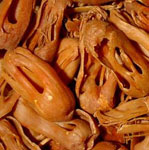
Dawk Jan, dok jan, szerecsendió-virág
The nutmeg tree, Myristica fragrans, is special in that it produces two separate spices, nutmeg and Mace. Mace is the ground outer covering (aril) of the nutmeg seed. A piece of unground Mace is called a blade. The orange outer covering of Nutmeg. Mace is used in making Mussaman curry paste. The plant is native to Indonesia.
•
Ka-Yang
Ka-yang is an herb that is eaten raw mostly by people
in Northeast Thailand and has an unusual flavour.
•
Poi Kak,
csillagánizs
The tan-coloured pods with eight points, like stars,
come from trees in the Magnolia family. Used in Thailand
primarily in dishes of Chinese origin, star anise is
unrelated to anise, but imparts a similar liquorice
flavour to dishes. Commonly found in Five-Spice Powder,
it is more often added whole to curries and soups. A
spice which is a feature of almost all Asian cuisine.
Star anise has a delicate aroma and has a distinctive
sweet liquorice taste. It must be roasted to bring out
the aroma before use.
•
Nam pla
halszósz
http://www.thaifoodandtravel.com/features/fishsauce1.html
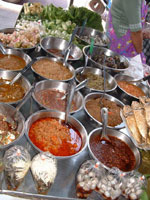
• Prik kaeng
Thai curry pastes (prik kaeng or prik gaeng)
Thai zöld fűszerpaszta
zöld csili paprika 31 %
citromcirok 21 %
fokhagyma 18,5 %
só 12,5 %
galangal 8 %
rákpaszta 4 % (só 17 %-ban)
kaffercitromhéj 2 %
koriandermag 1 %
bors 0.5 %
római kömény 0.5
kurkuma 0.5 %
Thai piros fűszerpaszta
szárított piros csilipaprika 35,5%
citromcirok 15,2 %
fokhagyma 12,2 %
só 12,2 %
salottahagyma 11,7 %
galangal 10,2 %
koriandermag 1,75 %
koriandergyökér 0,75 %
kaffercitromhéj 0,5 %
Thai sárga fűszerpaszta
citromcirok 23 %
fokhagyma 18,5 %
mogyoróhagyma (salotta) 18,5 %
só 15 %
galangal 8,5 %
szárított piros csili 7,5 %
koriandermag 3,5 %
kaffercitromhéj 2,5 %
római kömény 1 %
fahéj 0,5 %
csillagánizs 0,5 %
kurkuma 0,5 %
kardamom 0,5 %
Pungent dried fish and not less aromatic shrimp paste are ground together with fresh chiles, fragrant leaves (lemon grass, coriander, kaffir lime) and rhizomes (galanga, turmeric, fingerroot). Ranging between fairly hot and very hot.
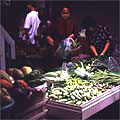
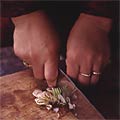
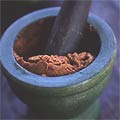
Thai Red Curry Paste
http://www.waitrose.com/food_drink/wfi/ingredients/herbsspicesseasoningsandcondiments/0204090.asp
An intense mix of aromatics is essential in true Thai curries, says cook Natalie Buchabun, left, from Hua Hin in Thailand. There are many recipes for curry paste, but Thai cooks agree that salty, pungent shrimp paste is crucial in creating an authentic flavour. The red paste recipe Natalie follows here is used in sweet-hot curries, in which meat is traditionally accompanied by bamboo shoots and, sometimes, green beans.
Makes enough for a curry for 4
Preparation time: 20 minutesIngredients
1 tsp coriander seeds
1 tbsp finely chopped dried red chilli (preferably from whole dried chillies, such as kashmiri)
1 tbsp finely chopped lemon grass
1 tbsp finely chopped ginger or galangal
1 tbsp finely chopped shallot
1 tbsp finely chopped garlic
1 tsp grated lime zest
1 tsp salt
5 cleaned coriander roots (optional, some specialist suppliers sell fresh coriander with roots attached)
1 tsp shrimp pasteInstructions
Heat a frying pan over a medium heat and add the coriander seeds. Toast gently until they begin to smell fragrant, then remove from the heat. Put the cooled seeds into a large mortar and crush with the pestle.Next, add the chilli, lemon grass and ginger or galangal to the mortar, and pound to a paste. This will take several minutes. Add the shallot, garlic, lime zest and salt (and the coriander root, if you're using it) and continue to pound to a paste. When all these ingredients have formed a smooth mixture, add the shrimp paste and pound again until well mixed. The paste is now ready to use.
To make a green paste, substitute one sliced fresh green chilli for the dried red one. You could also add a pinch of turmeric. A green paste is traditionally used in very hot curries.
Currying Flavour
For a smooth texture and even colour, use a pestle and mortar for curry paste. It's possible to use a food processor, but the texture will be coarse. If you want to make the paste this way, use a large quantity of ingredients (perhaps five times those given here). Small quantities will not be reduced to a paste in a processor.
To ensure a smooth paste, chop all the ingredients finely first. It's important to pulverise the harder ingredients, such as lemon grass, before you add the softer ones. The shrimp paste must be added last to smooth out the mixture.
Make sure you pound the paste until very smooth, otherwise your red curry will look more like a beige curry with red flecks. It's a good idea to make curry paste in large batches and then store small portions in plastic bags in the freezer. Alternatively, fry the paste in vegetable oil and store in the fridge. Cover the paste with a layer of oil to keep out air. In both cases, the paste will keep for up to six months.
When handling chillies, be careful not to touch your face. Some cooks wear rubber gloves when preparing chillies.
When cooking a Thai curry, always fry the paste first, so it releases its fragrance. This will improve the overall flavour of the dish.
Most Thai curries require very little cooking time, so keep some paste in the fridge ready for quick suppers.
Curry always tastes better the next day, so it is a great dish to prepare in advance.
Below, you'll find a guide to the basic recipes but, as usual, there's no need to be exact and there's nothing stopping you varying the proportions till you discover your own special favourite combination. Good luck!
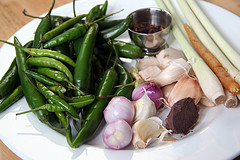
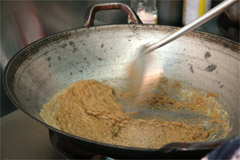
Green curry paste
12 small green chillies
2 Thai shallots
4 garlic cloves
small piece of fresh galangal - 1 teaspoon chopped (use ginger if you can't get it)
1 tablespoon fresh coriander root (or plant)
5 tablespoons chopped fresh lemon grass stalks
1 teaspoon fresh kaffir lime zest
1 teaspoon coriander seeds, roasted and ground
1 teaspoon roasted cumin seeds roasted and ground
2 teaspoons kapi (shrimp paste)
6 tablespoons vegetable oil
http://chezpim.typepad.com/blogs/2006/01/green_curry_wit.htmlRed curry paste
12 small red chillies
2 Thai shallots
2 garlic cloves
2 teaspoons chopped fresh galangal
1 tablespoon chopped fresh coriander root or plant
1 tablespoon chopped fresh lemon grass
2 teaspoons chopped fresh ginger
10 black peppercorns
1 teaspoon roasted coriander seeds
1 teaspoon roasted cumin seeds
1 teaspoon ground cinnamon
1 teaspoon ground turmeric
6 tablespoons vegetable oil
1 teaspoon saltMethod for both
If you are using a mortar and pestle, give yourself a start by chopping all the ingredients first. Otherwise take off the skins and stalks etc and bung it all, except the oil, in the processor. When it's as smooth as you can get it, transfer it to another container and start work with the handheld blender, gradually adding the oil until you get a homogenous paste. (I haven't seen any book recommend finishing with the hand blender but I find that it works well.) Transfer the paste to an airtight container if you're planning to store it.There are other types of curry pastes but these are the staples. They'll keep for ages in the fridge and you can freeze them too.Cook's notes
Don't substitute dried herbs and spices where the recipe calls for fresh, unless you reduce the quantities. Dried is always much stronger. However, if you can't get the proper ingredients you'll be better buying a commercial paste rather than making your own without the essentials.
http://www.flickr.com/photos/chezpim/sets/1148622/
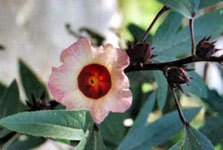
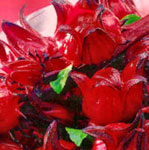
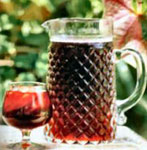
• Kra Jeab, karkadi tea
- Hibiscus sabdariffa
hibiszkuszvirág tea, vad-rozella, afrikai mályva, mályvacserje,
karkadé, Roselle, Red sorrel
Sorrel or Kra Jeab, also called Roselle. Sorrel
possesses twice the amount of Vitamin C of an orange. Food value, nutritionists
have found sorrel calyces to be high in calcium, niacin, riboflavin, iron, phosphorous,
thiamine, amino acids, citric ascorbic acid, citric acid, d-malic acid, tartaric
acid and hibiscic acid.
In Thai traditional medicine Roselle is used for the
treatment of various diseases and disorders including hypertension, hyperlipidemea,
bladder stone and gastric ulceration (Bunyapraphatsara, 1987). It was demonstrated
that Roselle could be used as an antispasmodic drink and antihypertensive as well
as anthelmintic in taeniasis and anti-bacterial agent (Sharaf, 1962). An aqueous
extract of Roselle was reported to be an effective diuretic in patients with urologic
disorders (Muangmun, 1982)

• Ehető
rovarok >>>Tovább
Thaiföldön közkedvelt a szöcske, sáska, tücsök, lótetű, óriás csíbor, vöröshangya-tojás
és a selyemhernyó is.
A rovarevés valaha az éhség legyőzésére szolgált. Manapság
azonban a thai-konyha tradíciójává vált, a rovarok ugyanis kitűnő fehérjeforrást
jelentenek. A piacokon sütve-főzve úgy árulják, mint nálunk a csirkecombot.
De
hogyan is készül az ínyenc eledel? A szöcskét kiöntik a csapdából, megmossák őket,
aztán harminc percig serpenyőben sütik, miközben jól befűszerezik. A fűszerezés
azért fontos, mert elveszi a rovar bűzét. A hangyatojásokat ellenben csak leforrázzák,
és jól megsózzák.
http://www.zoldmagazin.com/belso/edi.html
http://www.zetatalk.com/hungary/tfood12l.htm
http://www.zetatalk.com/hungary/tfood12d.htm
maengda-na, maeng-da (indiai tutajpoloska) - Lethocerus indicus Lep. & Serv. (= Belostoma indica Vitalis)
Thai giant waterbug [angol], punaise d'eau géante [francia], kepik air [indonéz], ca cuong [vietnami]
A tutajpoloska gorgonzola-sajt ízű potroh-nedve fűszerként mártogatós szószokba használatos. Kevés kell belőle, ritkasága miatt egyre drágább, ezért hamisítják is. Magát a bogarat is megeszik. 6-8 cm nagy, tavak, folyóvizek elárasztott rizsföldek ragadozója.
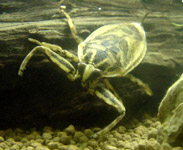
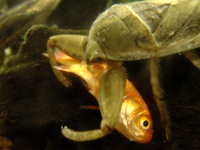
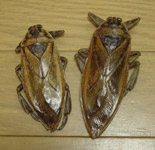
nam prik maengda
szósz összetört tutajpoloskából, só, cukor, fokhagyma, hagyma, halszósz, zöldcitromlé, csilipaprika hozzáadásával
•
Thai fragrant rice
jázminrizs
The
best rice to use for plain Thai rice is fragrant or jasmine rice.
First, rinse
the rice well in cold water to get rid of excess starch. Put the rice in a saucepan,
ideally one which has a tight-fitting lid. Cover with cold water - about two parts
water to one part rice. Bring to the boil and boil until rice is soft on the outside
but still hard in the centre. Drain off excess water (it takes practice to judge
this exactly right) leaving just enough for the almost cooked rice to absorb as
it finishes cooking. Put the lid on the pan and turn the heat right down. Let
the rice cook until all the remaining water has been absorbed. Take care not to
let the rice burn at the bottom of the pan.

• Thai mogyorószósz
120g mogyoróvaj
2 kanál víz
2 kanál szójaszósz
2 kanál almaecet
2 kanál cukor
1 kanál szezámolaj
Keverjük össze a vizet, szójaszószt, almaecetet és cukrot. Majd az egészet keverjük össze a mogyoróvajjal, végül a szezámolajjal.
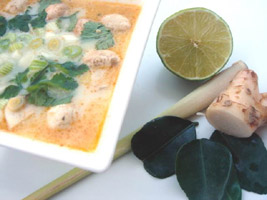
• Tom
kha gai, thai kókusztejes csirkeleves
http://chiliesvanilia.blogspot.com/2006/02/tom-kha-gai-thai-kkusztejes.html
A helyi konyhából egytálételek, sűrű levesek, sült tészták és különböző feltétek kerülnek ki. Általános szokás, hogy a vendégek számánál több fogás kerül az asztalra: zöld currys csirke, bazsalikomos disznó, csípős hal, tojássaláták, a tenger gyümölcsei, a lista szinte végtelen. Mindenki szed a tányérjára a hatalmas rizses fazékból, majd egyszerre több feltétből is merít rá. Aztán indul a soha meg nem unható kulináris lapátolás. Egy kanállal a csípősből, kettővel a savanykásból, egy darabka polip és jöhet az újabb kör.
A thaiok hagyományosan kézzel ettek, majd a nyugatosodás jegyében, valamikor a XIX. század második felében vezették be a villát és a kanalat. A történet szerint a király testvére, miután végignézett egy amerikai által tartott étkezési-etikett bemutatót, a nagy halom csillogó evőeszközből csak a kanalat és a villát választotta ki. Azokat találta praktikusnak, hiszen a legtöbb étel felszeletelve érkezik elénk. Fogjuk a kanalat a jobbunkba, a villát a balba, majd ez utóbbival halmozzuk az ételt a kanálra. Az pedig mehet befele. Az eszközök nem felcserélendőek, ugyanis nagy illetlenségnek számít villát a szájba venni. A pálcika csupán a tartalmas tésztalevesek vagy kínai eredetű ételek fogyasztásakor kerül elő.
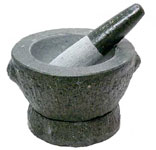
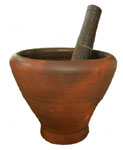
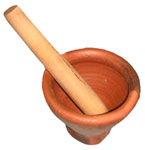
•
Krok
és saak
gránitmozsár és törő; van fa és cserépmozsár
is, van mélyebb a töréshez, laposabb az őrléshez
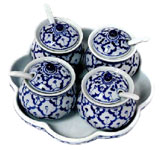
• Kruang
prung
Négy ízesítő, amit asztali (négyes) fűszertartó készletben
adnak fel:
1. Nam pla prik: karikákra szelt csilipaprika halszószban
2. Prik nam som: felkarikázott csilipaprika rizsecetben
3. Nam tan: cukor
4. Prik pon: őrölt piros csilipaprika
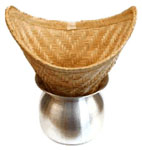
•
Ragacsosrizs-főző
Thai
sticky rice
This isn't a polite description of an overcooked mess! It's a
specific type of rice which is very popular in north and northeastern Thailand.
To eat, you roll it into a little ball and dip it into the food. Delicious! Soak
the rice for at least three hours, or overnight. Next, wrap the rice in muslin
and place in a steamer. If you don't have a steamer you can put the package in
a sieve or colander over a pan of water. Improvisation is often more satisfying
anyway. Bring the water to the boil. When the steam starts to come through the
package of rice, it's time to put the lid on and leave for about five minutes.
Test if it's cooked, ie not hard in the middle. If it is still hard replace the
lid and cook for a little while more.
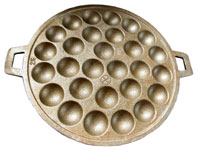
• Kanom krok sütő
•
Kude
maprow (khood maprow, kratai)
kókuszvájó,
coconut grater
Rendszerint egy darab tömör fából faragott nyúl alakú ülőke
kaparóvassal ("nyúl foggal").
Úgy ültek rá, mint egy nyeregbe.
•
Evőeszközök (villa, kanál,
evőpálca)
Villa és kanál, a bal illetve a jobb kézben (fordított, mint az
olasz pasta-evésnél), a villával kotorják rá az ételt a kanálra, majd a kanállal
viszik a szájhoz.
Csak levesben főtt tésztához (kuaytiaw nam) használnak evőpálcát.
Kést
nem adnak föl az asztalra.
•
Khantoke tálcaasztal
Hagyományos
alacsony lábú asztalka Észak-Thaiföldön. A vendégek dobogón ülik körbe a kerek
asztalt és osztoznak a ragcsos rizsen és egyéb fogásokon.
•
Ka-tha és ta-liu
vok
és a hozzávaló fém keverőkanál
•
Lung-theung
gőzölő
http://www.simply-thai.com/Thai-Market_Fresh_Vegetables_eng.htm
http://www.simply-thai.com/Thai-Market_Herbs_and_Spices_eng.htm
http://www.simply-thai.com/Thai-Market-thai_dry_goods-details.htm
http://www.plantnames.unimelb.edu.au/Sorting/sitemap.html
thai
növényfotók
http://home.hiroshima-u.ac.jp/shoyaku/ThaiPP.htm
Major
vegetables in Thailand
http://www.fao.org/docrep/004/ac145e/AC145E09.htm
http://www.fao.org/docrep/004/ac145e/AC145E00.htm#TOC
http://www.aidsthai.org/module/module20/index.php
http://www.simply-thai.com/Thai-Market_Fresh_Fruit_eng.htm
http://www.simply-thai.com/Thai-Market_Fresh_Vegetables_eng.htm
http://www.simply-thai.com/Thai-Market-dried-thai-Herbs-and-Spices.htm
http://www.simply-thai.com/thai-food-recipes-mortar-and-pestle.htm
http://www.simply-thai.com/thai-food-recipes-cooking-vocab.htm
http://importfood.com/freshthaiproduce.html
http://importfood.com/cookingsauces.html
http://www.templeofthai.com/
http://www.templeofthai.com/cooking/five_tastes_thai_cuisine.php
http://www.templeofthai.com/cooking/thai_cooking_ingredients.php
http://www.britishexpat.com/index.php?id=301
http://www.panix.com/~clay/cookbook/bin/show_ingredient.cgi?fish-sauce
http://www.nre.vic.gov.au/trade/asiaveg/thes-25.htm
http://www.thaifloriade.thaigov.net/hort_cd/herb/html/
rizs
http://www.britishexpat.com/index.php?id=299
mangó,
banán, sárkánygyümölcs
http://tfphotos.ifas.ufl.edu/10-01-04.htm
http://tfphotos.ifas.ufl.edu/OTHERFRUITS.HTM
egyéb gyümölcs